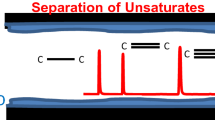Abstract
High pressure reverse-phase liquid chromatography has been used to separate saturated fatty acids, their methyl esters, polyunsaturated fatty acids, and triglycerides. Rapid separation of fatty acids differing in chain length and number of double bonds has been accomplished. Analysis time was less than 10 min in most cases. The high pressure reverse chromatography resulted in better separations of polyenoic acids than can be accomplished by conventional argentation silicic acid column chromatography. The analyses were carried out on a chemically bonded reverse phase packing, VYDAC reverse phase.
Similar content being viewed by others
References
Howard, G.A., and A.J.P. Martin, Biochem. J. 46:532 (1950).
Privett, O.S., and E.C. Nickell, JAOCS 40:189 (1963).
Applied Sciences Laboratories, “Technical Bulletin 30,” Applied Science Laboratories, State College, Pa., 1973.
Author information
Authors and Affiliations
About this article
Cite this article
Pei, P.TS., Henly, R.S. & Ramachandran, S. New application of high pressure reversed-phase liquid chromatography in lipids. Lipids 10, 152–156 (1975). https://doi.org/10.1007/BF02534153
Received:
Issue Date:
DOI: https://doi.org/10.1007/BF02534153




